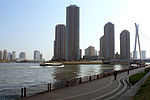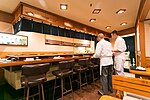Higashi-ginza Station
Internal link templates linking to redirectsRailway stations in Japan opened in 1963Railway stations in TokyoStations of Tokyo Metropolitan Bureau of TransportationToei Asakusa Line ... and 1 more
Tokyo Metro Hibiya Line

Higashi-ginza Station (東銀座駅, Higashi-ginza-eki) is a subway station on the Toei Asakusa Line, operated by the Tokyo Metropolitan Bureau of Transportation, and on the Tokyo Metro Hibiya Line. The Hibiya Line station is subtitled "Kabukiza-mae". The station is located in Ginza, Chūō, Tokyo, Japan. Its numbers are A-11 and H-10.
Excerpt from the Wikipedia article Higashi-ginza Station (License: CC BY-SA 3.0, Authors, Images).Higashi-ginza Station
Circle 1, Chuo
Geographical coordinates (GPS) Address Nearby Places Show on map
Geographical coordinates (GPS)
| Latitude | Longitude |
|---|---|
| N 35.6697 ° | E 139.7673 ° |
Address
銀座
Circle 1
104-0041 Chuo
Japan
Open on Google Maps







